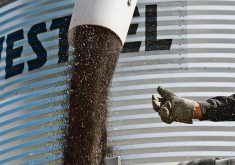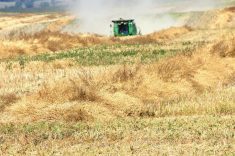Chuck Penner thought lentil prices might be heading for the stratosphere at the start of the 2021-22 crop year.
He wondered if growers might see red lentil prices of 50 or 60 cents per pound and large green lentils in the 70- to 80-cent range.
But demand hasn’t been as ravenous as first anticipated. Exports started out on fire in September and October and then went quiet.
Read Also

Forecast leans toward cooling trend
July saw below average temperatures, August came in with near to slightly above average temperatures and September built on this warming trend with well above average temperatures for the month.
A record Australian harvest hasn’t helped matters. The government pegs the crop at just over 800,000 tonnes but Penner thinks it is closer to one million tonnes.
Sales to India were already weak prior to the effects of Canada’s drought coming to light. Container shipping woes were another factor.
India is expected to harvest a near-record 1.58 million tonnes of lentils.
“I wouldn’t suspect that India is going to be coming in for big volumes of red lentils,” Penner said.
There could be decent green lentil demand from India, which may be why bids are up by three to four cents per pound of late.
The bright light in the lentil market has been Turkey, Penner told delegates to the Saskatchewan Pulse Growers’ 2022 Winter Pulse Meeting.
Growers in that country harvested an estimated 250,000 tonnes of lentils in 2021, about 100,000 tonnes less than the previous year.
It is once again dry in Turkey so there could be a repeat performance with the 2022 crop, which was planted in fall 2021.
That is the good news for Canadian growers. The bad news is that Turkey’s imports plummeted to almost zero in January due to the devalued lira and general economic turmoil.
But Penner thinks that was temporary and expects the country’s imports to pick up again.
However, Turkey recently announced it is prohibiting the re-export of a number of crops, including lentils. That could limit import demand.
Penner noted red lentil prices tend to spike in May and plummet in June as the new crop gets closer to harvest. Green lentils follow the same pattern but the spike isn’t as pronounced.
However, he wonders if this year will be different because markets have been so topsy-turvy.
Penner is forecasting a three percent increase in Canadian lentil acres in 2022, with no significant shift from reds to greens or vice-versa.
For average yield he is using the previous five-year average (including last year’s dismal crop) minus five percent, so something around 1,200 pounds per acre.
That will result in a partial recovery in red lentil supply to about 1.9 million tonnes, up from last year’s 1.5 million tonnes, but it will still be about 300,000 tonnes below normal.
Green lentil supply is pegged at 600,000 tonnes, which is even less of a recovery and well below recent yields of about one million tonnes, so supplies will be tight.
Penner warned growers that since many farmers are reluctant to forward contract production this year, due to last year’s problems in meeting the terms of those contracts, there could be a flood of lentils hitting the market right off the combine.
That would reduce prices even more than usual in the post-harvest period.
He also provided the caveat that if there is a repeat of drought, all lentil marketing ideas are “out-the-window.”
Contact sean.pratt@producer.com
















